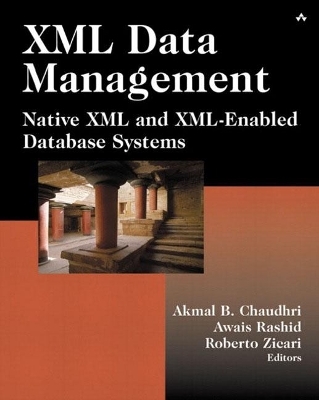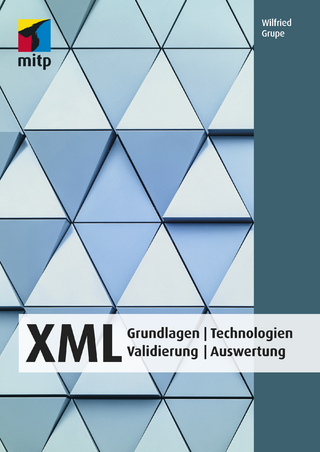
XML Data Management
Addison Wesley (Verlag)
978-0-201-84452-8 (ISBN)
Within a very short amount of time XML has become an essential part of almost every developer's arsenal of tools. It has affected every area of software. One of the fields where the impact of XML is still being worked out is in the world of databases and data management. Will XML and native XML databases replace traditional relational databases? How can XML be used as a tool to make relational databases even stronger? This book is intended to address these questions. It provides a discusssion of the various XML data management approaches employed in a range of products and applications. The book is based on a series of presentations at last year's OOPSLA conference. Topics covered range from using XML with Oracle9i or SQL Server to embedded XML databases to Tamino. Individual chapters are written by experts in those fields. In all cases the authors use concrete, practical examples, explore alternative approaches, and examine their strengths and weaknesses. There is no other book with the breadth of coverage offered here.
Akmal B. Chaudhri works for IBM developerWorks, where he is also Zone Editor for Special Projects. A recognized authority on objects and databases, he has been a regular presenter at many international conferences, including OOPSLA and Object World. In addition, he has edited several books on these topics. Awais Rashid is a Lecturer in the Computing Department of Lancaster University in the U.K. where he leads research into the application of new technologies, such as XML and aspect-oriented programming, and database systems. He has actively published on these topics and has organized a number of relevant international events. Roberto Zicari is a full Professor for Databases and Information Systems at the Johann Wolfgang Goethe University in Frankfurt/Main, Germany. He is an internationally recognized expert in Object Technology. He has consulted and lectured in Europe, North America, and Japan. 0201844524AB01312003
Preface.
Acknowledgments.
I. WHAT IS XML?
1. Information Modeling with XML.
Introduction.
XML as an Information Domain.
How XML Expresses Information.
Patterns in XML.
Common XML Information-Modeling Pitfalls.
Attributes Used as Data Elements.
Data Elements Used as Metadata.
Inadequate Use of Tags.
A Very Simple Way to Design XML.
Conclusion.
II. NATIVE XML DATABASES.
2. TaminoSoftware AG's Native XML Server.
Introduction.
Tamino Architecture and APIs.
XML Storage.
Collections and Doctypes.
Schemas.
Access to Other DatabasesTamino X-Node.
Mapping Data to FunctionsTamino X-Tension.
Internationalization Issues.
Indexing.
Organization on Disk.
Querying XML.
Query LanguageTamino X-Query.
Sessions and Transactions.
Handling of Results.
Query Execution.
Tools.
Database Browsing.
Schema Editing.
WebDAV Access.
X-Application.
Full Database Functionality.
Conclusion.
3. eXist Native XML Database.
Introduction.
Features.
Schema-less XML Data Store.
Collections.
Index-Based Query Processing.
Extensions for Full-Text Searching.
System Architecture Overview.
Pluggable Storage Backends.
Deployment.
Application Development.
Getting Started.
Query Language Extensions.
Specifying the Input Document Set.
Querying Text.
Outstanding Features.
Application Development.
Programming Java Applications with the XML:DB API.
Accessing eXist with SOAP.
Integration with Cocoon.
Technical Background.
Approaches to Query Execution.
Indexing Scheme.
Index and Storage Implementation.
Query Language Processing.
Query Performance.
Conclusion.
4. Embedded XML Databases.
Introduction.
A Primer on Embedded Databases.
Embedded XML Databases.
Building Applications for Embedded XML Databases.
Overview of Berkeley DB XML.
Configuration.
Indexing and Index Types.
XPath Query Processing.
Programming for Transactions.
Two-Phase Locking and Deadlocks.
Reducing Contention.
Checkpoints.
Recovery Processing after Failures.
Conclusion.
III. XML AND RELATIONAL DATABASES.
5. IBM XML-Enabled Data Management Product Architecture and Technology.
Introduction.
Product and Technology Offering Summaries.
DB2 Universal Database.
Information Integration Technology.
Current Architecture and Technology.
Shared Architecture and Technology.
XML Extender Architecture.
XML Extender Technology.
Using Both XML Collections and XML Columns.
Transforming XML Data.
Searching, Parsing, and Validating XML Data.
XML Extender Federated Support.
SQL XML Support Architecture.
SQL XML Support Technology.
Data Management Web Services Architecture.
Data Management Web Services Technology.
Information Integration-Specific Architecture and Technology.
Future Architecture and Technology.
The Vision.
Application Interface, Data Type, and API Goals.
Storage, Engine, and Data Manager Goals.
Why Support Both XML and Relational Storage in One System?
Why Not Object-Relational Long Term?
Impacted Technology Areas.
Conclusion.
Notices.
6. Supporting XML in Oracle9i.
Introduction.
Storing XML as CLOB.
Using CLOB and the OracleText Cartridge.
Search Predicates in OracleText.
XML-Specific Functionality.
Prerequisites.
XMLType.
Object Type XMLType.
Processing of XMLType in Java.
Using XSU for Fine-Grained Storage.
Canonical Mapping.
Retrieval.
Modifications.
Building XML Documents from Relational Data.
SQL Functions existsNode and extract.
The SQL Function SYS_XMLGen.
The SQL Function SYS_XMLAgg.
PL/SQL Package DBMS_XMLGen.
Web Access to the Database.
The Principle of XSQL.
Posting XML Data into the Database.
Parameterization.
Servlet Invocations.
Special Oracle Features.
URI Support.
Parsers.
Class Generator.
Special Java Beans.
Conclusion.
7. XML Support in Microsoft SQL Server 2000 165
Introduction.
XML and Relational Data.
XML Access to SQL Server.
Access via HTTP.
Using the XML Features through SQLOLEDB, ADO, and .NET.
Serializing SQL Query Results into XML.
The Raw Mode.
The Auto and Nested Modes.
The Explicit Mode.
Providing Relational Views over XML.
SQLXML Templates.
Providing XML Views over Relational Data.
Annotated Schemata.
Querying Using XPath.
Updating Using Updategrams.
Bulk Loading.
Conclusion.
8. A Generic Architecture for Storing XML Documents in a Relational Database.
Introduction.
System Architecture.
Installing Xerces.
The Data Model.
DOM Storage in Relational Databases.
The Nested Sets Model.
Creating the Database.
The Physical Data Model.
Creating User-Defined Data Types.
Creating the Tables.
Serializing a Document out of the Repository.
Building an XML Document Manually.
Connecting to the Repository.
The xmlrepDB Class.
Uploading XML Documents.
The xmlrepSAX Class.
Stored Procedures for Data Entry.
The uploadXML Class.
The extractXML Class.
Querying the Repository.
Ad Hoc SQL Queries.
Searching for Text.
Some More Stored Procedures.
Generating XPath Expressions.
Further Enhancements.
Conclusion.
9. An Object-Relational Approach to Building a High-Performance XML Repository.
Introduction.
Overview of XML Use-Case Scenario.
High-Level System Architecture.
Detailed Design Descriptions.
Conclusion.
IV. APPLICATIONS OF XML.
10. Knowledge Management in Bioinformatics.
Introduction.
A Brief Molecular Biology Background.
Life Sciences Are Turning to XML to Model Their Information.
A Genetic Information Model.
NeoCore XMS.
Integration of BLAST into NeoCore XMS.
Sequence Search Types.
Conclusion.
11. Case Studies of XML Used with IBM DB2 Universal Database.
Introduction.
Case Study 1: “Our Most Valued Customers Come First”.
Company Scenario.
How This Business Problem Is Addressed.
Future Extensions.
Case Study 2: “Improve Cash Flow”.
Company Scenario.
How This Business Problem Is Addressed.
Future Extensions.
Conclusion.
Notices.
12. The Design and Implementation of an Engineering Data Management System Using XML and J2EE.
Introduction.
Background and Requirements.
Overview.
Security Service.
Query Service.
Image Query Service.
Print Service.
Design Choices.
Using XML in OAI.
Conversion of XML Input into Objects.
Conversion of Database Data into XML.
Conversion of Image Data into XML.
Database Access.
Validation.
Future Directions.
XSLT.
Web Services.
Mass Transfer Capability.
Messaging.
Conclusion.
13. Geographical Data Interchange Using XML-Enabled Technology within the GIDB System.
Introduction
GIDB METOC Data Integration.
Background.
Implementation.
GIDB Web Map Service Implementation.
GIDB GML Import and Export.
Conclusion.
14. Space Wide Web by Adapters in Distributed Systems Configuration from Reusable Components.
Introduction.
Advanced Concept Description: The Research Problem.
Future Supporting Communications Satellites Constellations.
Integration of Components with Architecture.
Example.
Future Generation NASA Institute for Advanced Concepts, Space Wide Web Research, and Boundaries.
Advanced Concept Development.
The Research Approach.
The Research Tasks.
Conclusion.
15. XML as a Unifying Framework for Inductive Databases.
Introduction.
Past Work.
Extracting and Evaluating Association Rules.
Classifying Data.
Inductive Databases.
PMML.
The Proposed Data Model: XDM.
Basic Concepts.
Classification with XDM.
Association Rules with XDM.
Benefits of XDM.
Toward Flexible and Open Systems.
Related Work.
Conclusion.
16. Designing and Managing an XML Warehouse.
Introduction.
Why a View Mechanism for XML?
Contributions.
Outline.
Architecture.
Data Warehouse Specification.
View Model for XML Documents.
Graphic Tool for Data Warehouse Specification.
Managing the Metadata.
Data Warehouse.
View Definition.
Mediated Schema Definition.
Storage and Management of the Data Warehouse.
The Different Approaches to Storing XML Data.
Mapping XML to Relational.
View Storage.
Extraction of Data.
DAWAX: A Graphic Tool for the Specification and Management of a Data Warehouse.
Data Warehouse Manager.
The Different DAWAX Packages.
Related Work.
Query Languages for XML.
Storing XML Data.
Systems for XML Data Integration.
Conclusion.
V. PERFORMANCE AND BENCHMARKS.
17. XML Management System Benchmarks.
Introduction.
Benchmark Specification.
Benchmark Data Set.
Benchmark Queries.
Existing Benchmarks for XML.
The XOO7 Benchmark.
The XMach-1 Benchmark.
The XMark Benchmark.
Conclusion.
18. The Michigan Benchmark: A Micro-Benchmark for XML Query Performance Diagnostics.
Introduction.
Related Work.
Benchmark Data Set.
A Discussion of the Data Characteristics.
Schema of Benchmark Data.
Generating the String Attributes and Element Content.
Benchmark Queries.
Selection.
Value-Based Join.
Pointer-Based Join.
Aggregation.
Updates.
Using the Benchmark.
Conclusion.
19. A Comparison of Database Approaches for Storing XML Documents.
Introduction.
Data Models for XML Documents.
The Nontyped DOM Implementation.
The Typed DOM Implementation.
Databases for Storing XML Documents.
Relational Databases.
Object-Oriented Databases.
Directory Servers.
Native XML Databases.
Benchmarking Specification.
Benchmarking a Relational Database.
Benchmarking an Object-Oriented Database.
Benchmarking a Directory Server.
Benchmarking a Native XML Database.
Test Results.
Evaluation of Performance.
Evaluation of Space.
Conclusion.
Related Work.
Studies in Storing and Retrieving XML Documents.
XML and Relational Databases
XML and Object-Relational Databases.
XML and Object-Oriented Databases.
XML and Directory Servers.
Benchmarks for XML Databases.
Guidelines for Benchmarking XML Databases.
Summary.
20. Performance Analysis between an XML-Enabled Database and a Native XML Database.
Introduction.
Related Work.
Methodology.
Database Design.
Discussion.
Experiment Result.
Database Size.
SQL Operations (Single Record).
SQL Operations (Mass Records).
Reporting.
Conclusion.
21. Conclusion.
References.
Contributors.
Editors.
Chapter 1: Information Modeling with XML.
Chapter 2: TaminoSoftware AG's Native XML Server.
Chapter 3: eXist Native XML Database.
Chapter 4: Embedded XML Databases.
Chapter 5: IBM XML-Enabled Data Management Product Architecture and Technology.
Chapter 6: Supporting XML in Oracle9i.
Chapter 7: XML Support in Microsoft SQL Server 2000.
Chapter 8: A Generic Architecture for Storing XML Documents in a Relational Database.
Chapter 9: An Object-Relational Approach to Building a High-Performance XML Repository.
Chapter 10: Knowledge Management in Bioinformatics.
Chapter 11: Case Studies of XML Used with IBM DB2 Universal Database.
Chapter 12: The Design and Implementation of an Engineering Data Management System Using XML and J2EE.
Chapter 13: Geographical Data Interchange Using XML-Enabled Technology within the GIDB System.
Chapter 14: Space Wide Web by Adapters in Distributed Systems Configuration from Reusable Components.
Chapter 15: XML as a Unifying Framework for Inductive Databases.
Chapter 16: Designing and Managing an XML Warehouse.
Chapter 17: XML Management System Benchmarks.
Chapter 18: The Michigan Benchmark: A Micro-Benchmark for XML Query Performance Diagnostics.
Chapter 19: A Comparison of Database Approaches for Storing XML Documents.
Chapter 20: Performance Analysis between an XML-Enabled Database and a Native XML Database.
Index. 0201844524T02182003
| Erscheint lt. Verlag | 20.3.2003 |
|---|---|
| Mitarbeit |
Herausgeber (Serie): JOHN FULLER |
| Verlagsort | Harlow |
| Sprache | englisch |
| Maße | 188 x 230 mm |
| Gewicht | 1145 g |
| Themenwelt | Mathematik / Informatik ► Informatik ► Datenbanken |
| Informatik ► Programmiersprachen / -werkzeuge ► XML | |
| Mathematik / Informatik ► Informatik ► Web / Internet | |
| ISBN-10 | 0-201-84452-4 / 0201844524 |
| ISBN-13 | 978-0-201-84452-8 / 9780201844528 |
| Zustand | Neuware |
| Haben Sie eine Frage zum Produkt? |
aus dem Bereich
